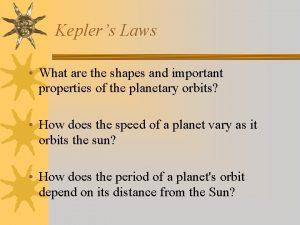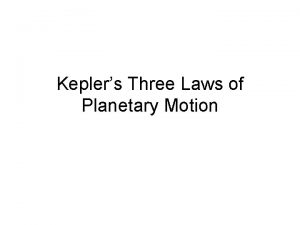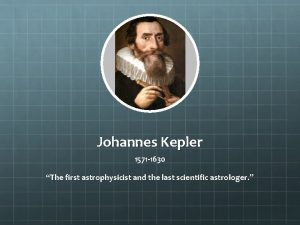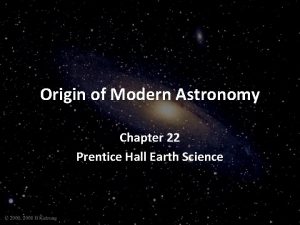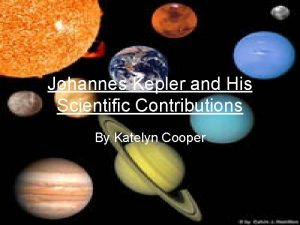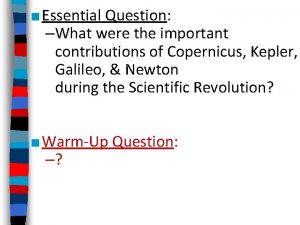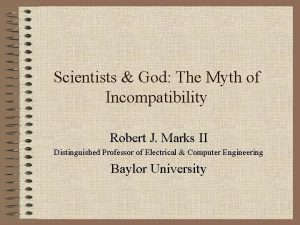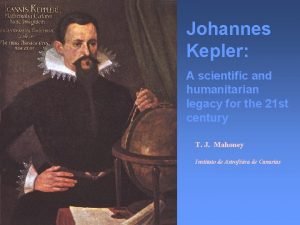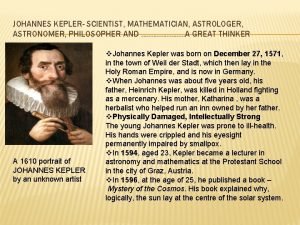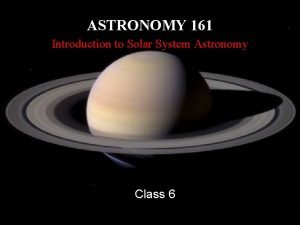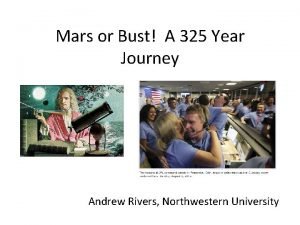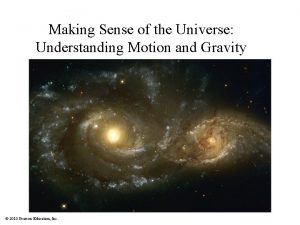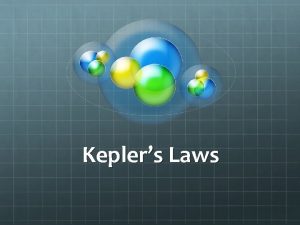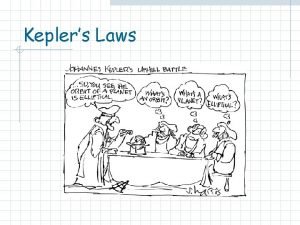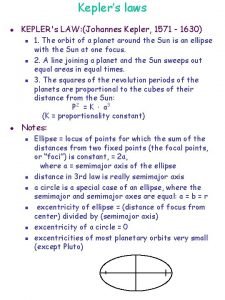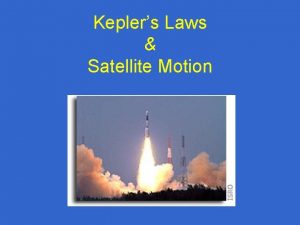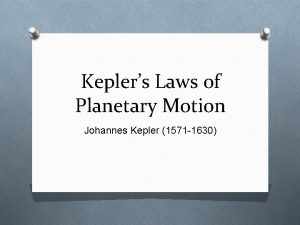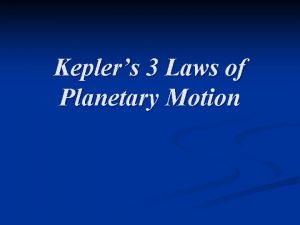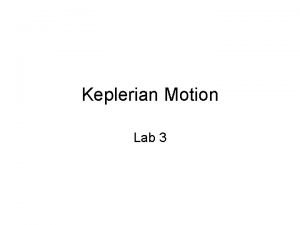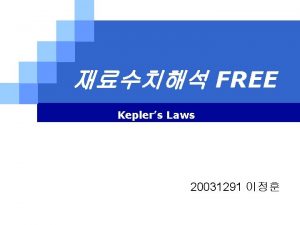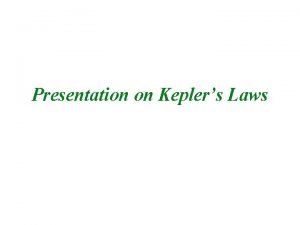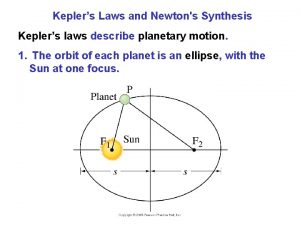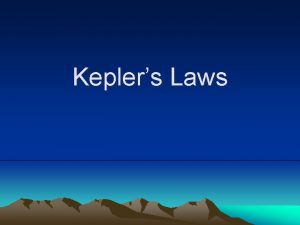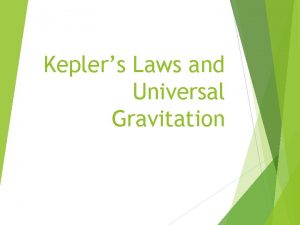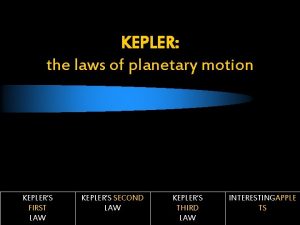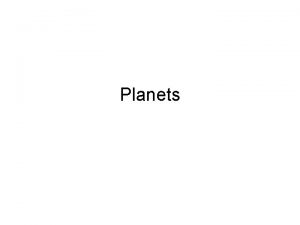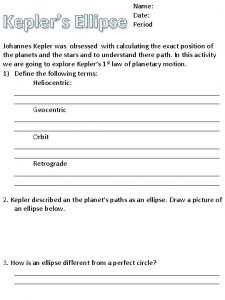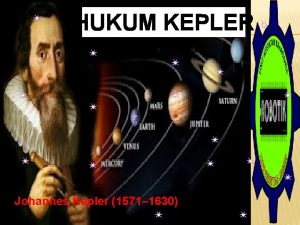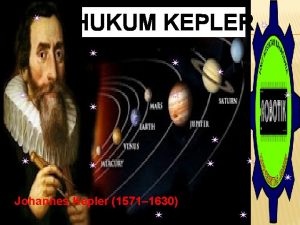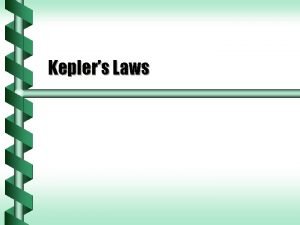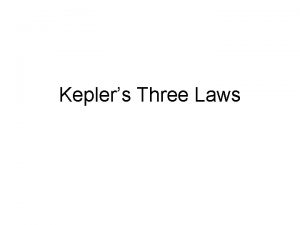The Motion of Planets Keplers laws Johannes Kepler

























- Slides: 25

The Motion of Planets Kepler’s laws Johannes Kepler

Kepler’s st 1 Law http: //physics. syr. edu/courses/java/mc_html/kepler. html ¬Each planet moves in an elliptical orbit, with the sun at one focus of the ellipse. Sun b ae a a = semi-major axis b = semi-minor axis e = eccentricity

Kepler's 2 nd Law ¬A line from the sun to a given planet sweeps out equal areas in equal times.

Variation of Speed of a Planet along its Orbit (1) This component of force does work on the planet. Gravitational Force Apogee (Lowest speed) The component of gravitational force parallel to the direction of motion is zero. Gravitational Force Perigee (Greatest speed)

Variation of Speed of a Planet along its Orbit (2) ¬At all points along the orbit, except at the apogee and perigee, there is a component of gravitational force parallel to the direction of motion of the planet. ¬The component of the force in the direction of motion does work to change the kinetic energy of the planet. So the speed of the planet also changes.

Conservation of Angular Momentum The rate at which area is swept out : r dθ In fact, the angular momentum of the planet is: So we have constant

Kepler’s rd 3 Law http: //javalab. uoregon. edu/dcaley/kepler/Kepler. html ¬The periods of the planets are proportional to the 3/2 powers of the major axis lengths of their orbits. For circular orbit, For elliptical orbit,

Derivation of Kepler’s 3 rd Law (1) ¬Consider a planet of mass m moving with velocity v in a circular orbit of radius r about the Sun. ¬Let M be the mass of the Sun. m ¬Hence we get r Thus v

Derivation of Kepler’s 3 rd Law (2) For steady speed, We substitute this formula into the above equation: We rearrange to get = constant

The graph of r³ against T² Slope of the graph = where M is the mass of the Sun

Mean Orbit Radii and Revolution periods for the Planets Planet Mercur y Venus Earth Mars Jupiter Saturn Uranus Neptune Pluto Period (Year) 0. 41 0. 615 1. 00 1. 88 11. 8 29. 5 84. 0 165 248 Average distance (a. u. ) 0. 39 0. 72 1. 00 1. 52 5. 20 9. 54 19. 18 30. 06 39. 44 T²/R³ (yr²/a. u. ³) 0. 98 1. 01 1. 00 1. 01 0. 99 1. 00

Conservation of Energy http: //surendranath. tripod. com/Keplers. Laws. html ¬Everywhere in its orbit, a planet has both kinetic energy and potential energy. ¬The sum of the KE and PE will be a constant all through the orbit. ¬PE is greatest when the planet is farthest away and least when it is closest to the sun.

Satellites http: //www. thetech. org/exhibits_events/online/satellite/home. html ¬A satellite is any object that orbits or revolves around another object. ¬For example, the Moon is a satellite of Earth, and Earth is a satellite of the Sun.

Artificial Satellite http: //solar. physics. montana. edu/YPOP/Classroom/Lessons/Orbits/index 7. html ¬Satellites come in many shapes and sizes and have many uses. – Communications – Earth remote sensing – Weather – Global positioning – Scientific research

Satellite Orbits ¬A satellite's orbit depends on its task, speed, and distance from Earth. – Low earth orbit (LEO) – Polar orbit – Geosynchronous equatorial orbit (GEO) – Elliptical orbit

Parking Orbit ¬A parking orbit is a temporary orbit for a spacecraft which is expected to – perform an injection burn into a higher orbit – break or escape orbit, leaving influence of the body around which it is orbiting – perform a decent burn to enter or re-enter the atmosphere of the body around which it is orbiting and then land

Launching Speed ¬Each orbit requires a certain speed called launching speed. ¬The greater the orbit radius, the smaller the speed.

Geostationary(Geosynchronous) Satellite ¬The geostationary satellites orbit the equatorial plane of the Earth at a speed matching the Earth’s rotation. ¬a satellite in GEO always stays directly over the same spot on Earth.

Total Energy of a Satellite ¬The kinetic energy of a satellite is ¬The potential energy of a satellite is ¬The total energy of a satellite is

Velocity of Escape ¬ Escape velocity is the minimum velocity with which an object must be fired from the Earth in order to escape completely from the gravitational attraction of the Earth. ¬ To escape from the attraction of the Earth, the total energy of an object must exceed its potential energy at infinity. ¬ That is

Possible Path of a projectile http: //www. phy. ntnu. edu. tw/java/projectile. Orbit. html v part of ellipse hyperbola parabola circle ellipse

Weightlessness ¬Weightlessness is the absence of the sensation of weight. ¬Weightlessness can be achieved by – going to a place distant from any object so that the gravitational force is nearly zero. This is real weightless, – falling together with a freely falling elevator, – orbiting a planet so that both the man and the spacecraft are falling together at the same rate.

Microgravity http: //microgravity. grc. nasa. gov/new/school. htm ¬Weightlessness in outerspace is more correctly termed microgravity.

Flying Laboratory ¬ To achieve a short-term micro-gravity, the aircraft flies in a parabolic pattern (Kepler curve), rising to a height of about 20, 000 feet, and then curving downward.

Simulated Gravity with Centripetal Force ¬ While the station is spinning, the wall of the space station would apply a centripetal force on the person to keep them travelling in a circular path. The acceleration felt by the person would be the centripetal acceleration. By adjusting the rotational velocity (v) of the space station we could literally adjust the amount of the simulated gravity.
 Kepler law
Kepler law Keplers three laws
Keplers three laws Kepler's three laws of planetary motion
Kepler's three laws of planetary motion Johannes kepler ausbildung
Johannes kepler ausbildung Johannes kepler
Johannes kepler Aportaciones de galileo galilei
Aportaciones de galileo galilei Johannes kepler myspace
Johannes kepler myspace Johannes kepler
Johannes kepler Tycho brhe
Tycho brhe Johannes kepler prezi
Johannes kepler prezi Johannes kepler heliocentric model
Johannes kepler heliocentric model What did johannes kepler believe in
What did johannes kepler believe in Johannes kepler
Johannes kepler Johannes kepler legacy
Johannes kepler legacy Cosmo graphical mystery was written by
Cosmo graphical mystery was written by Johannes kepler
Johannes kepler Johannes kepler contribution in mathematics
Johannes kepler contribution in mathematics Why do jovian planets have rings
Why do jovian planets have rings What separates the inner and outer planets?
What separates the inner and outer planets? What is each planet made of
What is each planet made of Inner terrestrial planets
Inner terrestrial planets What do the first four outer planets have in common?
What do the first four outer planets have in common? Keplers phase funnel
Keplers phase funnel Keplers law
Keplers law How does newton's law of gravity extend kepler's laws
How does newton's law of gravity extend kepler's laws Kepler's second law of motion
Kepler's second law of motion
